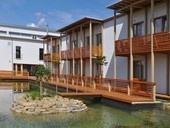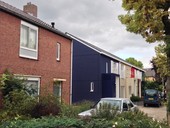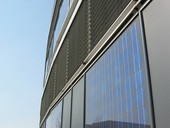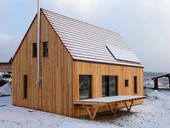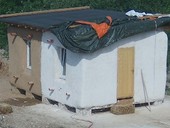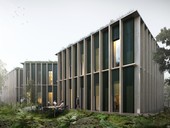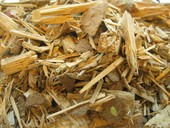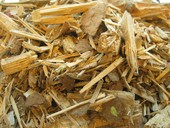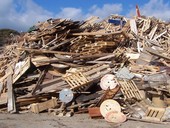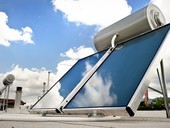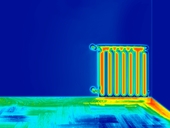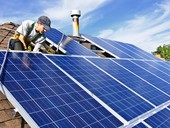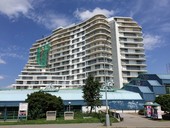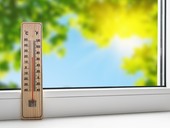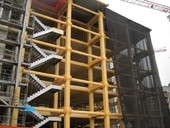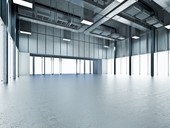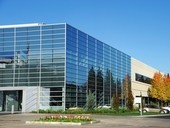In residential buildings, the quality of the indoor environment can be verified by the satisfaction rates of the people who live in them. One of the forms that can provide the necessary information is a subjective assessment. This form of survey was carried out with residents of the passive apartment building for seniors in Modřice. There were 25 women and 12 men of an average age of 77 years participating in the survey. The survey proved that seniors were able and willing to accept the terms of passive houses.
Archiv článků od 17.4.2017 do 27.8.2018
The paper describes actual trends in serial deep energy retrofitting of buildings in the Netherlands. A set of photographs presents several Dutch pilot projects of energy retrofitting of post-war family houses in Heerlen, Melick and Soersterberg to net zero energy level and of one multifamily residential building in Arnhem to nearly zero energy level. The retrofitting projects were made utilizing prefabricated thermal insulation wall modules with timber structural system (that included new windows) and prefabricated roof panels. All presented projects also featured replacement of energy sources and in case of the family houses also installations of photovoltaic systems replacing roof tiles.
Innovative technologies incorporated in building constructions are able to produce renewable energy. The submitted paper deals with the current status of photovoltaic (PV) integration in building facades by selected systems. The main emphasis is focused on the newest concepts and their current development, specifically of those in combination with other progressive materials and technologies.
In contemporary architecture, straw is used marginally, mostly in do-it-yourself construction. Although the convenient qualities of straw have long been known, it has not gained the trust of builders and designers. Construction companies have not learned to work with straw on a regular basis. In the scope of green technologies, an opportunity is emerging to use straw in professional building systems suitable for sustainable architecture. If we want to apply it in our architectural designs, we have several possibilities. The common small straw bales are suitable for many ways of structure and do-it-yourself process. This way of building process can be interrupt by logistic problems or weather disaster. Contemporary building market offers professional products made of straw: universal strongly pressed boards or system of modular units for external walls. All these ways of application are able to gain the high building quality. The innovative straw technologies enable to design and erect the energy passive house with considerable percentage of straw in constructions. Although the advantages of straw are indisputable, the next success of straw building materials depends on the interest of architects and builders.
The article describes full-scale fire experiment of a single-storey object made of straw bales covered with clay and lime plaster. Motivation, course and results are shown, particularly focused on global fire behaviour in fire of such construction as well as its contribution to separation distances.
It is expected that the new administrative centre of Lesy České republiky would be an exemplary demonstration of the use of wood, which will be used in the form of the building material or in which the importance of wood will be emphasized in another appropriate way. The paper is focused on a proposal that won the international architectural competition in 2016.
Wood and the materials on its basis fulfil the requirements of an ever-evolving and accelerating society. In addition to naturally grown wood, wood-based materials are frequently used as a basic material for production of furniture and for building constructions as well. Looking at changes in waste management, a significant shift from the waste to the circular economy can be observed. The valuable raw materials are kept in the production cycle instead of landfilling or burning. Wood and wooden products can be efficiently separated in waste management, reused and recycled. The so-called wood waste – old furniture, wooden pallets, window and door frames, demolition wood, used lumber, bark and other wood residues can be reused in particleboard production. Particle board manufacturers in the Czech Republic have adopted progressive waste management and currently use 60% of recycled wood into particle boards. A completed life cycle analysis (LCA) of OSB demonstrates that replacing of 50% of natural fibres with recycled wood has significant environmental benefits. The objective is to push furthermore on effective legislation to promote waste material utilization and thus lead to a more sophisticated waste wood collecting.
Wood and the materials on its basis fulfil the requirements of an ever-evolving and accelerating society. In addition to naturally grown wood, wood-based materials are frequently used as a basic material for production of furniture and for building constructions as well. Looking at changes in waste management, a significant shift from the waste to the circular economy can be observed. The valuable raw materials are kept in the production cycle instead of landfilling or burning. Wood and wooden products can be efficiently separated in waste management, reused and recycled. The so-called wood waste – old furniture, wooden pallets, window and door frames, demolition wood, used lumber, bark and other wood residues can be reused in particleboard production. Particle board manufacturers in the Czech Republic have adopted progressive waste management and currently use 60% of recycled wood into particle boards. A completed life cycle analysis (LCA) of OSB demonstrates that replacing of 50% of natural fibres with recycled wood has significant environmental benefits. The objective is to push furthermore on effective legislation to promote waste material utilization and thus lead to a more sophisticated waste wood collecting.
Wood and the materials on its basis fulfil the requirements of an ever-evolving and accelerating society. In addition to naturally grown wood, wood-based materials are frequently used as a basic material for production of furniture and for building constructions as well. Looking at changes in waste management, a significant shift from the waste to the circular economy can be observed. The valuable raw materials are kept in the production cycle instead of landfilling or burning. Wood and wooden products can be efficiently separated in waste management, reused and recycled. The so-called wood waste – old furniture, wooden pallets, window and door frames, demolition wood, used lumber, bark and other wood residues can be reused in particleboard production. Particle board manufacturers in the Czech Republic have adopted progressive waste management and currently use 60% of recycled wood into particle boards. A completed life cycle analysis (LCA) of OSB demonstrates that replacing of 50% of natural fibres with recycled wood has significant environmental benefits. The objective is to push furthermore on effective legislation to promote waste material utilization and thus lead to a more sophisticated waste wood collecting.
One of the most well-known and most important greenhouse gases is carbon dioxide (CO2), which arises from natural processes, but the burning of carbonaceous fuels, especially fossil fuels, contributes significantly in the last century. This text focuses on CO2 emissions associated with energy transformations for the supply of energy to buildings.
Family houses with the concept of electric heating by means of an electric boiler or electric direct heating system and the preparation of hot water in an electrically heated tank do not meet the requirement for the energy performance of buildings. The authors analyze the magnitude of the conversion factor and other parameters that would meet ENB requirements.
The article deals with the process of energy optimization of a unique rental housing complex to a high energy standard. It analyzes the identified problems of the initial energy baseline of the building, which should be declared to meet the requirements for a high energy standard. It analyzes and substantiates each step of the process from an energy specialist‘s and an investor’s point of view.
The article deals with the analysis of a possible solution of a non-energy residential building. The analysis shows what energy sources help to achieve a zero balance of non-renewable primary energy and what is not. In the contribution, the investment solution and the real operating costs of the energy-zero residential building compared to the current solution are shown for the selected solution and a simple payback period is set.
At present, there is growing interest in the realization of multi-storey wooden buildings. In the case of multi-storey wooden buildings, their safety, stiffness and acoustics are of key importance. The submitted paper focuses on the issue of fire safety of multi-storey wooden buildings, which is currently the subject of major discussions.
Mandatory standard of building design – nearly energy zero starts for larger industrial buildings from 1st January 2018. This will have a major impact, especially in the design of the building envelope. This article analyzes whether the current setting of requirements of this building standard is technically and economically achievable. Analysis is based on typical industrial building.
Design of building envelope, that means layers of so called boundary constructions; is the key procedure within the design process. It might seem that this step is crucial only for industrial buildings with low-energy ambitions or those that are intended for international environmental certification. This article is focusing on valid Czech legal requirements and also on the coming nearly energy zero standard of buildings.
zpět na aktuální články
